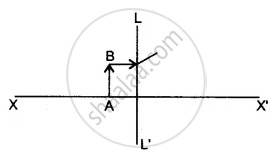Advertisements
Advertisements
Question
A student uses a lens of focal length 40 cm and another of –20 cm. Write the nature and power of each lens
Solution
Power of first lens, `P_1 = 1/(f(m)) = 1/0.4 = 2.5 D`
The given lens is a converging lens i.e. a convex lens.
Power of second lens, `P_2 = 1/f(m)` = `-1/0.2` = -5D
The given lens is a diverging lens i.e. a concave lens.
APPEARS IN
RELATED QUESTIONS
Ranbir claims to have obtained an image twice the size of the object with a concave lens. Is he correct? Give a reason for your answer.
A combination of lenses for a camera contains two converging lenses of focal lengths 20 cm and 40 cm and a diverging lens of focal length 50 cm. Find the power and focal length of the combination.A optical instrument in which the above arrangement of convex lens is used is a convex lens used to burn paper by focusing sunlight.
A converging lens has a focal length of 50 cm. The power of this lens is:
State the condition for the following a lens has both its focal lengths equal .
How is the power of a lens related to its focal length?
Define power of a lens. Write its units. Deduce the relation `1/f =1/f_1 +1/f_2`for two thin lenses kept in contact coaxially.
A symmetric double convex lens is cut in two equal parts by a plane containing the principal axis. If the power of the original lens was 4 D, the power of a divided lens will be
Complete the diagram to show the formation of the image of the object AB.

(i) Name the Lens LL’.
(ii) Where is the image of the object AB formed?
(iii) State three characteristics of the image.
According to Rayleigh’s scattering law, the amount of scattering of light is inversely proportional to the fourth power of its ______.
The focal length of a double convex lens is equal to the radius of curvature of either surface. What is the refractive index of its material?
